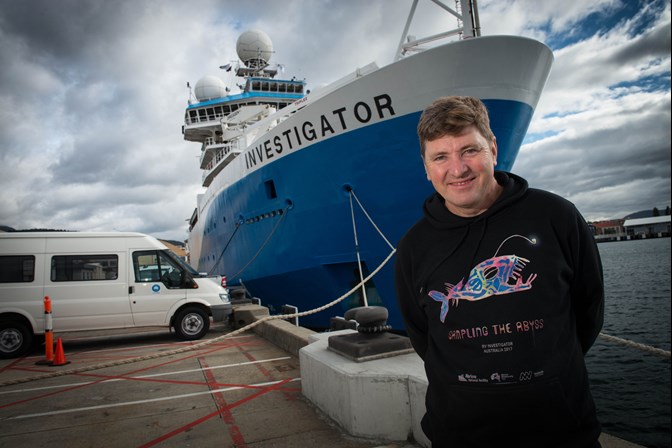Museums Victoria leads world-first research voyage to uncover life in Australia's eastern abyss
An international team of 40 scientists is set to embark on a pioneering deep-sea research voyage that will uncover the mysterious life that inhabits the abyss off eastern Australia – an almost unexplored habitat 4000 metres below the surface.
Called Sampling the Abyss, the month-long voyage on the Marine National Facility research vessel Investigator brings together scientists from Museums Victoria, CSIRO and other Australian and international museums and research agencies. The voyage departs Bell Bay (Launceston, Tasmania) on 15 May and will visit seven Commonwealth marine reserves (CMRs) – from the Freycinet CMR off eastern Tasmania to the Coral Sea CMR off central Queensland – before finishing in Brisbane on 16 June.
This will be the first time the biodiversity of these abyssal areas has been explored and the scientists are expecting to discover many new deep-sea species.
Dr Tim O’Hara, Museums Victoria’s Senior Curator, Marine Invertebrates and Chief Scientist of Sampling the Abyss said:
"The abyss is the largest and deepest habitat on the planet, covering half the world’s oceans and one third of Australia’s territory, but it remains the most unexplored environment on Earth."
"We know that abyssal animals have been around for at least 40 million years, but until recently only a handful of samples had been collected from Australia’s abyss."Tim O'Hara
The abyss is a world of crushing pressures, no light, little food and freezing temperatures. Research in other parts of the world has found that the animals that live there have evolved highly unique ways to survive.
At these huge depths it is so dark that creatures often have no eyes or produce their own light through bioluminescence. As food is scarce, animals are often small and move slowly. Many are jelly-like and spend their lives floating about, while others have ferocious spines and fangs and lie in wait until food comes to them.
What lies in wait in the deepest parts of Australia’s ocean for us to discover? And why is it so important to understand?
Dr Tim O'Hara explains:
"The data gathered on this trip will be crucial to understanding Australia’s deep-sea habitats, their biodiversity and the ecological processes that sustain them. This will assist in its conservation and management and help to protect it from the impacts of climate change, pollution and other human activity."
The research team will use a high-tech multi-beam sonar to map the structure of the seafloor, and cameras, nets and sleds to sample habitats 2500 and 4000 metre depths. In the deepest parts of the ocean it takes seven hours to lower and raise this equipment from the seafloor.
Scientists expect to find a range of animals, including new species, of fish, starfish, molluscs, crabs, sponges, marine worms and sea spiders.
Back in the lab, scientists will map patterns of biodiversity and evolution across the seafloor, and analyse the chemistry and DNA of tissue samples to reconstruct deep-sea food webs and discover links between deep-sea populations.
The team will be bringing the Australian deep-sea alive though photography and video on 'Blogging the Abyss' and Museums Victoria, CSIRO and the Marine Biodiversity Hub social media.
The Sampling the Abyss voyage is being led by Museums Victoria, with support from the CSIRO Marine National Facility and National Environmental Science Programme’s Marine Biodiversity Hub.
Interviews, images, video interviews, vision and further information is available.
Video interviews are available with:
- Dr Tim O'Hara, Museums Victoria (voyage leader)
- Jason Mundy of Parks Australia
- Ben Rae, Marine National Facility
- Dan Gledhill, CSIRO Australian National Fish Collection

